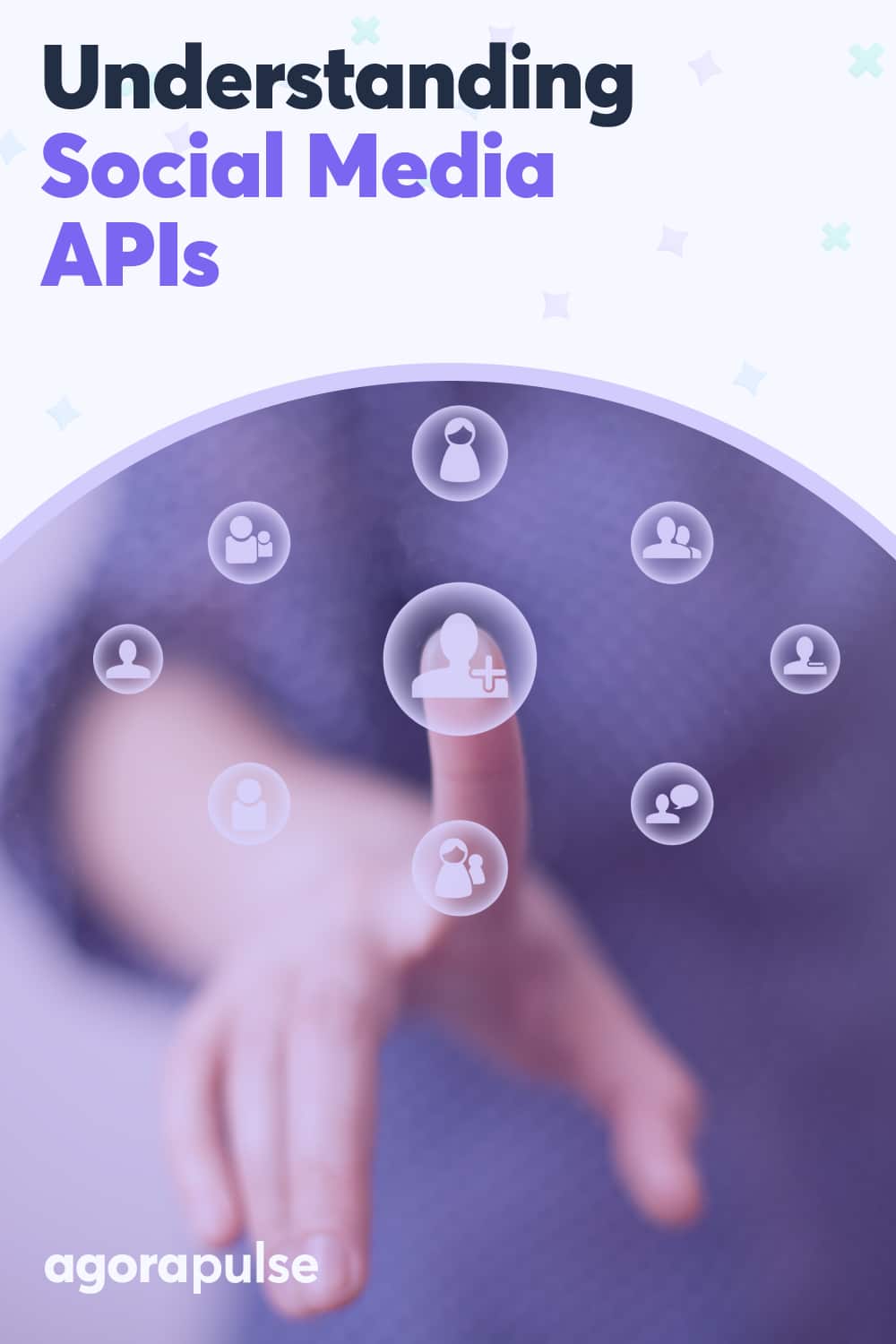The challenge of managing multiple social media accounts across different platforms is familiar to every social media manager. Each platform has its unique interface, analytics, and content scheduling systems, making management of multiple social profiles both time-consuming and tedious. This is where using a social media API can come in handy. But what exactly are APIs, and how do they change the way we manage social media? Let’s dive in.
What Are APIs?
An API, or Application Programming Interface, is a set of rules and protocols that allows different software applications to communicate with each other. APIs are what allows apps to borrow functionality and data from each other, enabling developers to create powerful software that integrates and operates seamlessly with other services.
In the context of social media, all of the major social media networks offer various APIs that allow third-party tools (like Agorapulse) to access some of their features or data.
You can find the specific details of the APIs for each social media network on their site for developers:
Why does this matter to you? Well when you use a tool like Agorapulse, which integrates these APIs, you can:
- Streamline your workflow: Think of how tedious it is trying to manage several social media profiles by manually logging into each one, multiple times a day. Social media APIs let tools like Agorapulse centralize where you post updates, respond to messages, and create reports.
- Automate repetitive tasks: No more copying and pasting the same post into different platforms or setting multiple alarms to ensure you post at peak times for different time zones. APIs allow you to automate these tasks, so you can focus on more important tasks, instead of getting bogged down by the minutiae of posting schedules.
- Gain cross-platform insights: With APIs, you’re not just seeing isolated snapshots of engagement metrics from each platform. Instead, you get a comprehensive, integrated view of how all your content is performing across all social media platforms. This means better insights, smarter strategy adjustments, and a clearer understanding of your ROI on social media.
Essentially, social media APIs are what make the communication between Agorapulse, and each social media platform’s server, possible.
But how exactly does this communication happen? Let’s break it down.
Get a free trial of Agorapulse right now!
The Basics of API Communication
Here are the foundational concepts you need to know about API communication:
Request and response
API communication involves a request made by one application (the client) and a response from another (the server).
The client sends a request to the server to perform an operation, such as retrieving data or executing a command. The server processes this request and sends back a response.
Endpoints
Each API has specific endpoints, which are URLs representing various functionalities the API offers.
For example, a social media API might have separate endpoints for fetching posts, posting new content, or managing user profiles. An endpoint for fetching user profiles might look something like https://api.socialmedia.com/users/{user_id}.
HTTP Methods
APIs typically use HTTP (Hypertext Transfer Protocol) methods to specify the type of action the client wants to perform.
Common methods include:
GET to retrieve information.
POST to create a new record.
PUT or PATCH to update existing information.
DELETE to remove information.
Request headers and authentication
Request headers provide additional information to the server, such as the type of response format the client expects (e.g., JSON or XML) or authentication details.
Authentication is crucial for security, ensuring that only authorized users can access or modify data. APIs often use tokens, API keys, or OAuth for authentication.
Parameters and body
Clients can send parameters in the URL to filter the data they’re requesting. For example, a request to an API might include parameters specifying the number of items to return or a specific time range. For methods like POST or PUT, the client also sends a body containing the data to be created or updated.
How Social Media APIs Work in Action
Let’s consider a simple example involving a social media management tool such as Agorapulse, that uses an API to post a new message on a user’s profile.
Step 1: Preparation
First, the user composes their message within Agorapulse, specifying any additional options like the publishing date and time, or any video or images that go with the post.
Step 2: Agorapulse creates the API request
Endpoint: Agorapulse then uses the API’s endpoint for creating new posts. For example, if the social media platform were “Facebook,” the endpoint might be https://api.facebook.com/v1/posts.
HTTP Method: POST.
On a sidenote, it’s not called POST because you’re creating a social media post. (Which is highly misleading, if you ask me!)
The term POST simply refers to any time you are creating a new resource or sending data, so it is used in many other situations, such as adding a new user to a database, submitting a form on a website, or uploading a file.
Headers:
Authorization: Carries credentials, like an OAuth token, to authenticate the request.
Content-Type: Indicates the format of the data being sent; typically application/json for JSON-formatted data.
Request Body: Contains the message to be posted. For example:
{
"content": "Excited to share this update with you all!",
"media_ids": ["456", "789"], // Optional, if images or videos are attached
"scheduled_time": "2024-04-10T14:00:00Z" // Optional, for scheduling
}
Step 3: Sending the request
Then Agorapulse sends the request to the social media platform’s API endpoint.
Step 4: The social media platform processes the request
Upon receiving the request, the social media platform’s API:
-
- Authenticates the request using the provided credentials.
-
- Validates the request data to ensure the post adheres to the platforms guidelines (content type, size limits, etc.)
-
- Creates the new post on the user’s profile with the provided content and attachments, immediately or scheduled as requested.
Step 5: Response and confirmation
The API responds to Agorapulse with details of the created post, including a success status and the post’s ID.
{
"status": "success",
"post_id": "123456789",
"message": "Your post has been successfully created."
}
This shows just how smoothly APIs let different programs talk to each other, making even the complicated task of managing social media a lot less tedious.
Types of APIs
However, not all access to the APIs is created equal. Different types of access—namely, open, partner, and internal APIs—dictate how data is shared, the level of control available, and the scope of possible interactions.
Open APIs
These are publicly available and can be used by anyone interested. They are designed to be user-friendly, with ample documentation and tools for easy integration.
Check out Agorapulse’s Analytics Open API!
Open APIs allow developers and third-party tools to access a wide range of features or data from social media networks, including posting updates, accessing follower counts, or retrieving analytics. However, they may impose restrictions to safeguard user data and ensure platform stability.
Partner APIs
Partner APIs provide a deeper level of access compared to open APIs, but they are available only to verified partners of the social media platform. Access to partner APIs often requires a formal application and approval process to ensure that the tool or application aligns with the social networks policies and security standards.
This level of API is typically used for advanced integrations that offer more extensive access to a service’s features or data than what’s available through open APIs. For example, Agorapulse is a official partner with Meta, which allows us to offer features that are not possible with the open APIs alone.
Internal APIs
These are used within the boundaries of an organization and are not exposed to external developers or third parties. Internal APIs facilitate communication and data sharing between different systems and services within the social media platform, improving efficiency and integration across various parts of the service.
While internal APIs may not directly affect the range of external services Agorapulse can integrate with, they do play an important role in the tool’s backend efficiency and scalability.
Internal APIs can streamline the process of aggregating data from various sources, improving the reliability and performance of Agorapulse’s services. They also support the development of new features by enabling different components of Agorapulse to communicate seamlessly with each other.
Understanding and navigating these types of APIs is key for social media management tools to maximize their capabilities, offering comprehensive, efficient services to their users while adhering to the platforms’ data use policies and restrictions.
Understanding Social Media API Limitations
While social media APIs expand the capabilities of social media platforms, it’s important to note that they also come with certain limitations. These constraints are not arbitrary but stem from various factors, including the following:
Security and privacy
One of the primary reasons for API limitations relates to security and user privacy. Social media platforms are entrusted with vast amounts of personal data, making it imperative to safeguard this information responsibly. As a result, APIs may restrict access to sensitive user data or certain actions to prevent misuse and ensure compliance with data protection regulations.
This is also why when connecting Facebook or other social media platforms to third-party tools, you are shown a screen that asks you what types of information and data you are willing to share.
Platform control
Social media platforms strategically manage their ecosystems by determining what functions they make available through APIs. This approach allows them to maintain a high-quality user experience, control how their platform is used by third-party applications, and encourage certain types of engagement. As such, if a functionality isn’t offered by an API, it’s often a deliberate choice by the platform to protect its interests and user experience.
Changes to platform policies
The world of social media is constantly changing, and so are the policies of social media platforms. Changes in an API’s offerings can occur, sometimes with little notice, affecting how third-party tools like Agorapulse interact with the platform. These changes are usually in response to shifting user needs, regulatory environments, or platform strategy adjustments.
In Conclusion
APIs are the backbone and driving force behind many third-party tools, including Agorapulse. And it is these APIs which allow us to provide an all in one platform that enables social media managers to significantly improve their results on social media.






